What to do in Zaanse Schans
Frequent travelers often express a certain disdain for places that are “touristy,” meaning crowded with tourists: San Marco’s square in Venice, for example, or the Tower of London, or the Forbidden City in Beijing. Many of us avoid such places, preferring the more off-the-beaten-track destinations.
Disclosure: This post contains affiliate links. If you click on one of them and spend money, I will receive a small percentage of what you earn. This will not affect your price.
[Last updated October 24, 2025]
Tourist destinations, though, are popular for a reason. San Marco’s square is beautiful. The Tower of London and the Forbidden City reveal some fascinating history, and they’re beautiful as well.
I bring this up because I visited one of these very popular destinations last weekend: Zaanse Schans, north of Amsterdam.
Never heard of it? Well, you’ve probably seen pictures, since it’s home to a collection of historical windmills and is visited by buses full of tourists from all over the world.
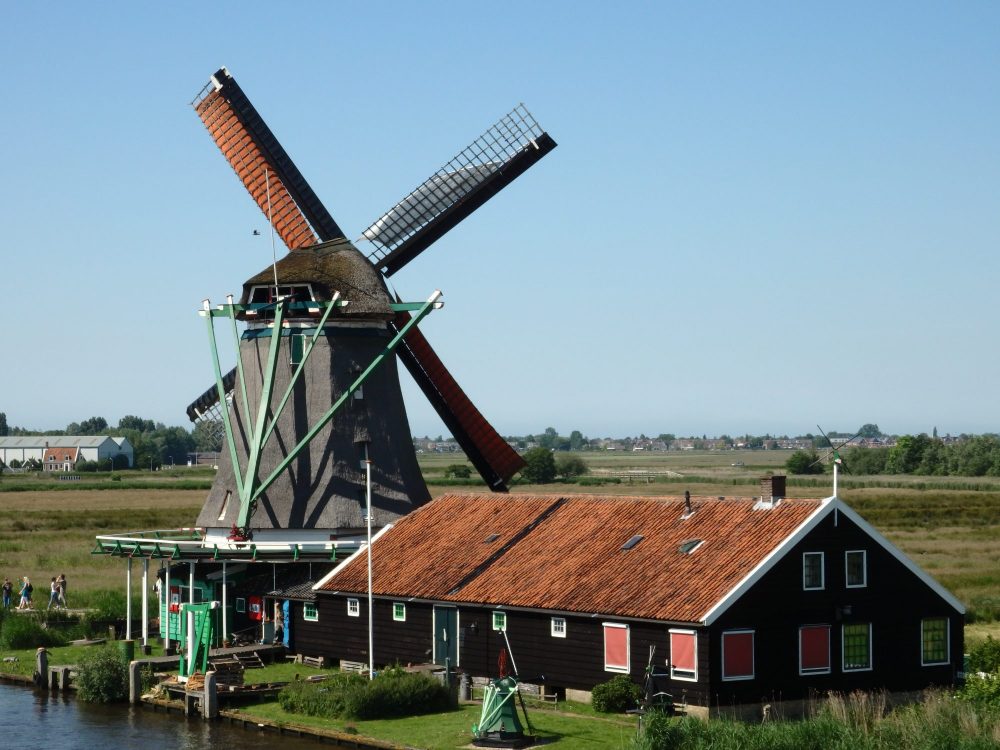
My husband and I went on a Sunday, and not only were the tourist hordes there in full force, but a children’s book fair was also taking place, bringing in the locals and their over-excited children.
Nevertheless, I loved seeing the windmills. I’d been there before on much quieter days; during the week and off-season it’s much less crowded. The problem is that many of the windmills close during the week, so I never got to see the insides. On a summer Sunday, almost all of them were open and in operation too. The video below will give you a quick impression of how they looked in action:
History of Zaanse Schans
The area around Zaanse Schans, called the Zaanstreek, used to have 600 windmills powering its economic growth until the age of the steam engine. Built for industrial functions, they were used for grinding grain, cacao, spices or paint; sawing wood, or pressing oil.
Starting in the 1960s, these historical mills and other threatened and antique buildings were moved to Zaanse Schans to create a collection and to preserve them. Many of them are simple residences, so by moving them here, a lovely village was created along the river.
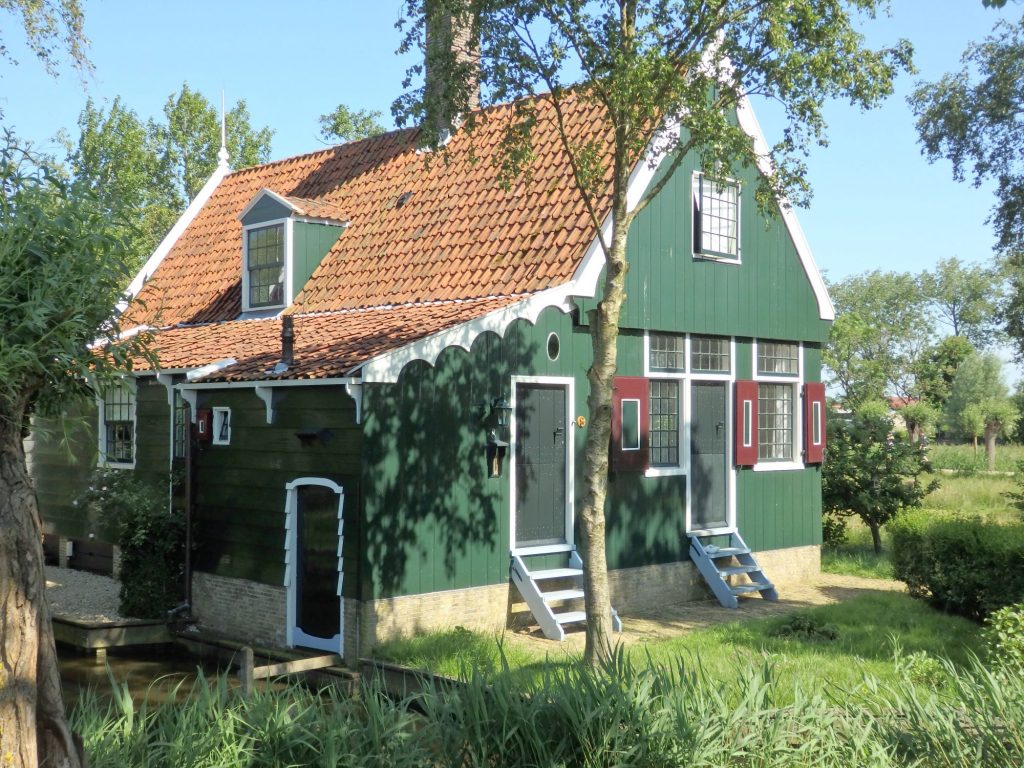
Things to see in Zaanse Schans
There’s plenty to see at Zaanse Schans. Most people come for the row of picturesque windmills arranged along the Zaan River. But it’s also home to a number of small museums, most of them housed in centuries-old buildings brought here from nearby towns, craft workshops, and various old-style shops, along with the cluster of private homes, still occupied today. Just strolling around the place, taking in the cute houses and shops, is a very pleasant way to spend an afternoon.
If you want to see windmills and aren’t sure where the best place to see them is, make sure to read my post Kinderdijk or Zaanse Schans? to help you make the decision.
The windmills of Zaanse Schans
- De Huisman (1756) was a mustard mill and now makes other spices too.
- De Gekroonde Poelenburg (1869) is a sawmill.
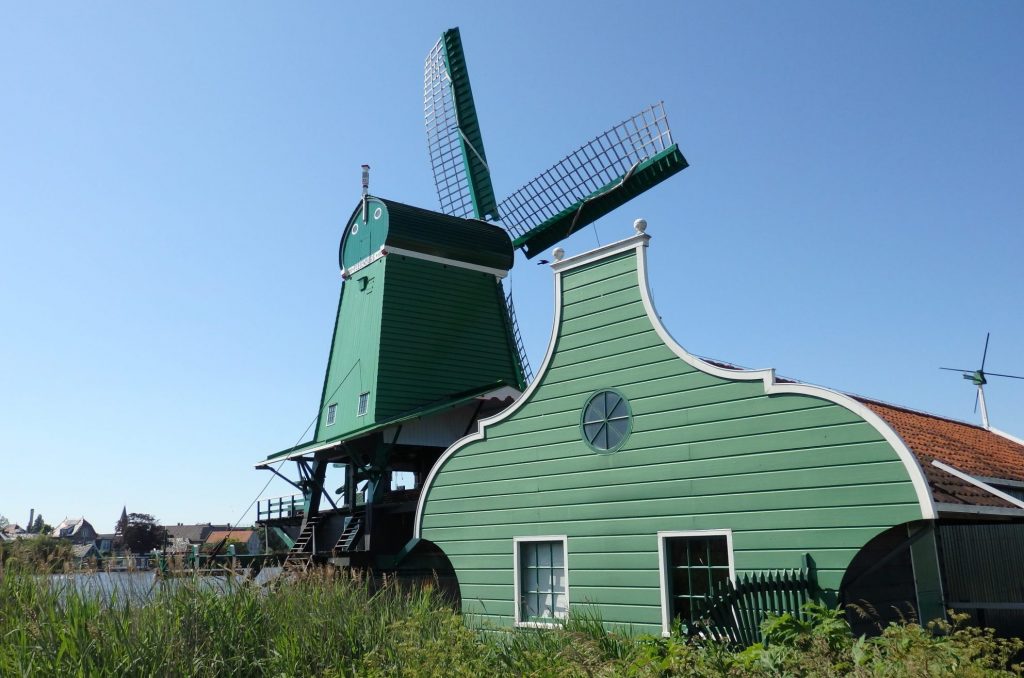
- De Kat (1664) is one of two mills (along with De Bonte Hen) that were originally built on this spot. This one is a paint mill, still grinding wood and pigment and other ingredients for artists and restorers to this day.
- De Zoeker (1672) is an oil mill producing peanut oil.
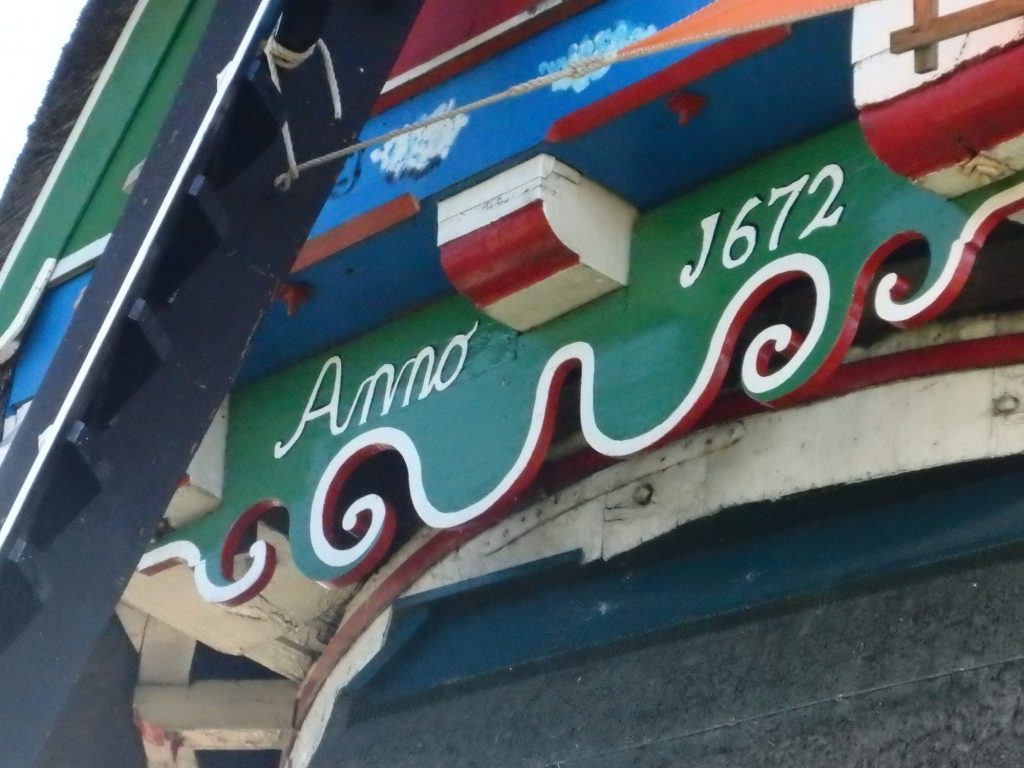
- Het Jonge Schaap is a recent reconstruction of a much older sawmill. It was fascinating for me to watch how the mill powers the up and down of the saw blades at the same time as the very slow sideways movement to carry the wood past the saws.
- De Bonte Hen (1693) is also an oil mill, making oil from flaxseed. The seeds are first crushed to remove the husks, then pressed. The windmill works to lift huge beams of wood which drop repeatedly to press the oil out of the seeds.
- De Os (1663) was an oil mill, but its wind vanes and top were removed in the 20th century and replaced by a diesel motor.
- Het Kalverblad (1986-2005) is a small wipmolen – the whole top part of the structure can be rotated to face the wind. It looks small, but powers to sawmill under it.
- De Bleeke Dood (1782) is the oldest surviving stellingmolen, which means it was originally in a town so it had to stand high above the buildings and has a “gallery” around it. It grinds grains into flour.
- De Ooievaar (1622) was an oil mill.
Each mill is individually operated, mostly by volunteers, and they’re not all open to visitors. To enter any of them, buy a Ticket Zaanse Schans.
Book accommodations nearby Zaanse Schans in Zaandam or find a place in Amsterdam.
Despite the tourist crowds, you can see on the video above that Zaanse Schans is pleasant when the weather is good and the mills are working. When we got there, well past noon, we headed straight for the furthest mill, De Bonte Hen. That worked well because the tourists were mostly wrapping up their visit for the day, focusing on the gift shops near the entrance (cheese, mustard, chocolate, etc.). We had some of the mills more or less to ourselves, and were able to ask the millers questions.
We worked our way along the row of mills and were able to see most of the main ones, though that left no time to see any museum.
The museums at Zaanse Schans
A ticket to Zaanse Schans includes several worthwhile museums.
- The Zaans Museum and Verkade Experience: The Zaandam region was home to a number of factories, and still is. The windmills in the collection here, after all, all served industrial functions. The Zaans Museum looks at the food industry, with displays and interactive exhibits about the history of the local food producers, particularly those producing cookies and various sweets. Verkade chocolate is still produced in a factory nearby, and at the museum you can learn about early-20th-century chocolate production.
- The Windmill Museum: This museum explains the actual windmills at the site. Here you can learn about all the different types of windmills as well as about what this region was like with it had many hundreds of them. It has lots of interactive exhibits. This seems like one that would be best to visit before you go see a windmill so you have a clearer idea of what you’re looking at.
- The Zaanse Time Museum: This museum contains lots of historical clocks, all in working order. It’s noisy with all that ticking and chiming! It also tells the history of Dutch clockmaking, particularly in the Zaandam region. The building itself dates to the 17th century.
- Heritage Chambres Kalverringdijk: A 1650 merchant’s house, closed at the moment, but being renovated to bring it back to its original interior.
- Albert Heijn Museum Shop: Housed in a 19th-century wooden building, this reconstruction illustrates what the original Albert Heijn general store – now a chain of supermarkets – looked like a hundred years ago.
- Bakery Museum de Gecroonde Duyvekaer: A museum/shop about old-fashioned bakeries, containing a collection of antique baking equipment. It also sells old-fashioned Dutch baked goods.
- Honig Breethuis: Built in 1710, this house decorated to show how a merchant and his family lived in about 1830.
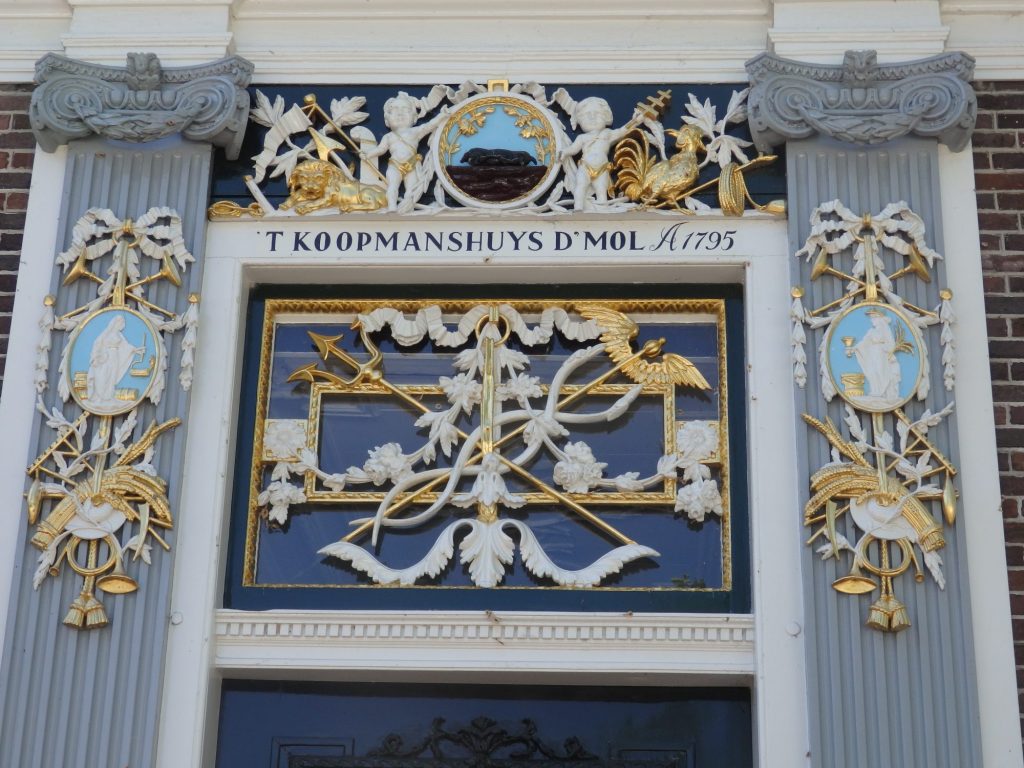
Other things to see
Several craftsmen also display their work, including a distiller, the “Blik op Cacao,” a candlemaker, a weaver, a clog maker, a goldsmith and a pewtersmith. At the Blik op Cacao, you can taste hot chocolate. The cheese shop is fun: taste some samples, learn about cheese production and, of course, buy some to take home. At the clog workshop you can learn about how clogs were made and, again, buy some.
You’ll find restaurants, cafes, and various “old-timey” shops within the reconstructed village.
Visiting Zaanse Schans
If you go to Zaanse Schans, set aside a whole day to see it well. The grounds are open daily 9:00-17:00 and admission to the grounds is free, but you’ll need a ticket to enter any of the attractions.
Tickets and opening hours
The ticketing has changed since I was last there. Nowadays, it seems you have to buy the Ticket Zaanse Schans if you want to enter any of the attractions. The ticket includes two mill entrances, plus the Molenmuseum (windmill museum), the Zaanse Museum and Verkade Experience and the Museum Zaanse Tijd. It also includes the cooper’s workshop (Kuiperij), the weaver’s workshop, the Heritage Chambres Kalverringdijk, and an audio tour.

Windmills: The Huisman, De Kat and Het Jonge Schaap windmills are open daily. De Bonte Hen is open Tuesday-Sunday but only in April to September. De Zoeker windmill is only open on Saturdays. Being open doesn’t mean they’ll be in operation; that depends on the weather.
Museums: The Zaanse Museum and Verkade Experience, the Windmill Museum, the Zaanse Time Museum and the bakery are all open daily all year. The Albert Heijn Museum Shop is open Saturday and Sunday only all year. The Honig Breethuis is open Friday, Saturday and Sunday all year.
Handicrafts: The cooper and weaver are only open April to September, but the other workshops – the ones that double as shops – are open all year: Blik op Cacao; the cheese shop; the clog workshop; the distillery; and the tiny pewter workshop.
Accessibility
Only some sections are wheelchair-accessible: the paths, the bridges and the Zaanse Museum, where there’s also a wheelchair-accessible toilet. The only windmill that is wheelchair-accessible is Het Jonge Schaap.
Getting there
By train: Take the train in 17 minutes from Amsterdam Central Station to the Zaandijk – Zaanse Schans stop and walk about 15 minutes from there or take a taxi or pedicab.
By car: The address is Schansend 7 in Zaandam. There is a parking lot which charges a fee.
My travel recommendations
Planning travel
- Skyscanner is where I always start my flight searches.
- Booking.com is the company I use most for finding accommodations. If you prefer, Expedia offers more or less the same.
- Discover Cars offers an easy way to compare prices from all of the major car-rental companies in one place.
- Use Viator or GetYourGuide to find walking tours, day tours, airport pickups, city cards, tickets and whatever else you need at your destination.
- Bookmundi is great when you’re looking for a longer tour of a few days to a few weeks, private or with a group, pretty much anywhere in the world. Lots of different tour companies list their tours here, so you can comparison shop.
- GetTransfer is the place to book your airport-to-hotel transfers (and vice-versa). It’s so reassuring to have this all set up and paid for ahead of time, rather than having to make decisions after a long, tiring flight!
- Buy a GoCity Pass when you’re planning to do a lot of sightseeing on a city trip. It can save you a lot on admissions to museums and other attractions in big cities like New York and Amsterdam.
Other travel-related items
- It’s really awkward to have to rely on WIFI when you travel overseas. I’ve tried several e-sim cards, and GigSky’s e-sim was the one that was easiest to activate and use. You buy it through their app and activate it when you need it. Use the code RACHEL10 to get a 10% discount!
- Another option I just recently tried for the first time is a portable wifi modem by WifiCandy. It supports up to 8 devices and you just carry it along in your pocket or bag! If you’re traveling with a family or group, it might end up cheaper to use than an e-sim. Use the code RACHELSRUMINATIONS for a 10% discount.
- I’m a fan of SCOTTeVEST’s jackets and vests because when I wear one, I don’t have to carry a handbag. I feel like all my stuff is safer when I travel because it’s in inside pockets close to my body.
- I use ExpressVPN on my phone and laptop when I travel. It keeps me safe from hackers when I use public or hotel wifi.




This is absolutely charming. . .I’d wait for a week-day, I think but I sure am tempted to put it high on the ‘bucket list’ after reading your post.
You’ll love it!
I love saying Zaanse Schans, it just rolls of the tongue doesn’t it? And of course it is a beautiful place. I guess I would put up with the crowds to get inside more of the windmills. Great video!
It’s not easy to say, but I know what you mean! Glad you liked the video!
Hi Rachel, The windmills look wonderful all working together. I’ve seen them many years ago – too many to remember much. Maybe I saw different ones. I never thought about them powering saws. How amazing would it have been to see 600!
It’s amazing, when you’re inside, to see how heavy all the machinery is: huge beams and wooden gears. Yet those massive sails are able to get it all moving. I suppose if there were 600 they’d seem ordinary!
I would not mind visiting this place even though it is considered touristy. The history and beautiful colors are a draw for me. I would try to visit early during a weekday though.
Probably wise, unless you want to see inside all the windmills, in which case you should check the hours for each.
It looks fascinating and I’m not at all familiar with it so thanks for sharing. 🙂
You make a good point. There’s only one Sagrada Familia and if you want to see it there’s only one place to go. 🙂 You have to try to pick your time, that’s all.
Picking your time can help a lot. Off-season or weekdays or early in the morning would all work for any touristy place.